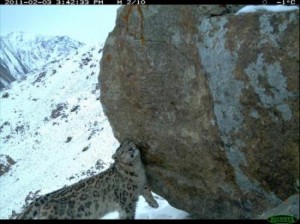
Team commemorates opening of Mount Noshaq to climbers. Anthony Simms from WCS Afghanistan. Photo WCS.
After the recent good news of remote cameras photographing more snow leopards in Afhganistan comes another piece of good news. The country’s highest mountain, Mount Noshaq (7492 metres) is again open to the mountaineering community after many years closure due to conflict and insecurity.
Mount Noshaq is located in important snow leopard habitat in the Hindu Kush Mountains of the Wakhan Corridor. Other important species on the mountain are Marco Polo sheep, urial and ibex (wild goat), all snow leopard prey.

Afghani villagers at conservation education program. Photo Haqiq Rahman WCS.
The Wildlife Conservation Society’s Afghanistan Program Technical Advisor, Anthony Simms commemorated the opening with a climbing expedition a few weeks ago. He was accompanied by a team, which included Tim Wood (the first Australian to reach the summit) and Aziz Beg (only the third Afghan national to reach the summit).
During the 1970’s Afghanistan was a major destination for many young international tourists going across Asia to Europe and I was one of those, spending 5 wonderful weeks there one winter. I’m so delighted that this area, with snow leopards, is now safe again.

Recent camera trap photo of snow leopard in Afghanistan suggests more cats in the Wakhan region than previously thought.Photo WCS.
“This expedition marks the revival of a once popular tourist site that was forgotten during the country’s political unrest,” said Peter Zahler, Deputy Director of WCS’s Asia Program. “Despite the turmoil that continues in some parts of the country, Wakhan is just one of a number of areas in Afghanistan that are very safe from a security standpoint, and where tourism is already providing jobs and improved livelihoods for local people while providing an incentive to protect the country’s fragile environment and wildlife.”
Well done WCS! They are are working with over 50 local communities across the country to help management of natural resources and building community conservation programs that protect wildlife and improve villagers’ livelihoods. They’ve trained 59 community rangers to monitor snow leopards and other species and supporting conservation education in schools. More information see WCS Afghanistan Program.




{ 0 comments… add one }